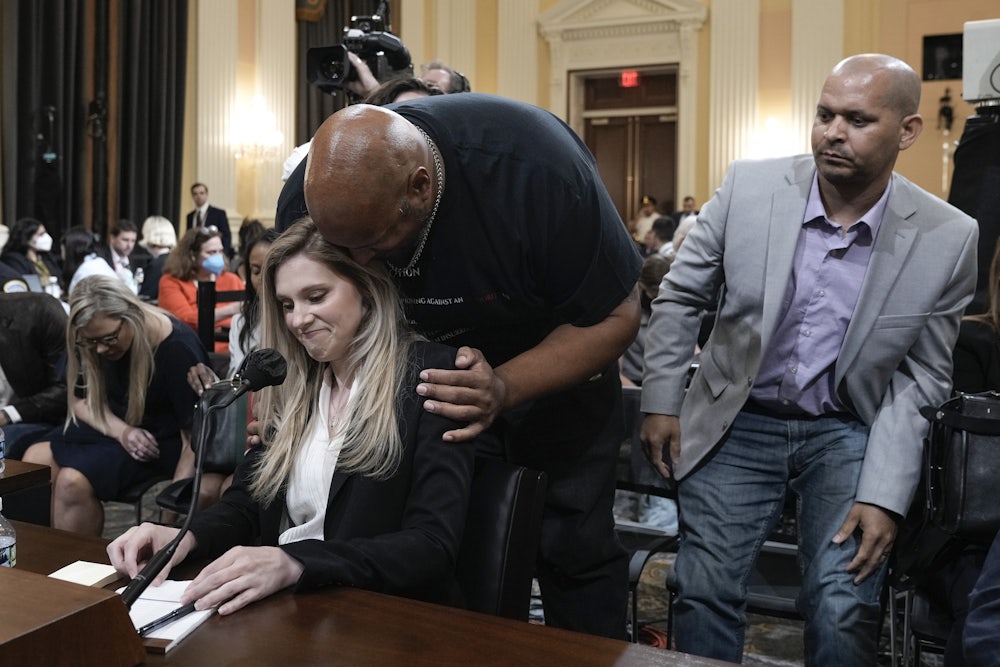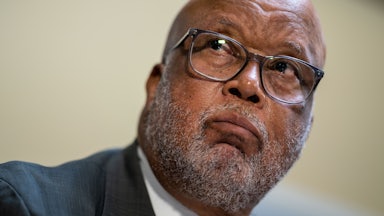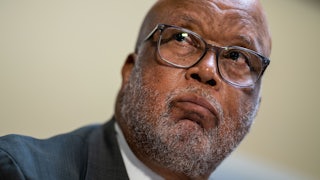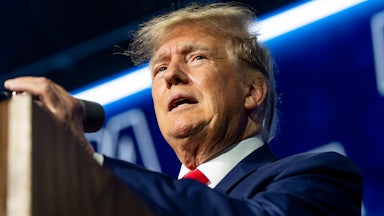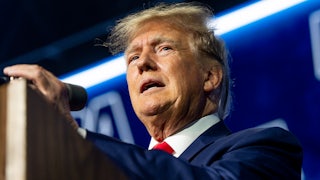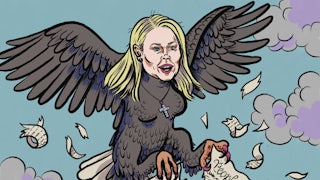Eighteen months after a mob of former President Donald Trump’s supporters overran the Capitol in an effort to overturn the presidential election, the House select committee investigating the January 6, 2021, insurrection held its first public hearing outlining what members presented, unequivocally, as a coordinated conspiracy abetted by the president himself.
This being the committee’s big debut, it was a production worthy of prime time. The hearing was a slickly produced, made-for-television affair, weaving videos as well as in-person testimony from two key witnesses. James Goldston, a former ABC News president, consulted on the hearings, assisting the committee in presenting thousands of pages of documents and hundreds of interviews as digestible, TV-friendly bites. While subsequent public hearings will take place during the day, this hearing began at 8:00 p.m.—with almost every broadcast network giving it first billing. Chair Bennie Thompson began the hearing by thanking the American people for “sharing part of your evening” with the committee.
But this was more than simply the pilot episode of the January 6 show. The committee had several daunting tasks: to reestablish events that took place a year and a half ago in the public consciousness, to state the thesis of the argument that Trump was central to the execution of the riot, and to set up the subsequent hearings that will take place in the coming days.
Despite all the professional packaging and the new revelations from teases of high-profile witness testimony—one highlight of which was Trump averring that Vice President Mike Pence “deserved” the chants by rioters calling for him to be hanged—the most affecting elements of the hearing rested in what could not be scripted: raw footage of the violence and moving testimony. Whether the hearings will be successful in breaking through to the American people, and accomplishing the even more aspirational goal of shifting the public from its entrenched political camps, will ultimately rest on the power of seeing and hearing the facts.
The crux of the hearing lay in its video evidence: This included testimony from some of the hundreds of interviews conducted by the committee but also, more compellingly, footage of the riot itself. A lengthy video clip, featuring never before seen footage, showed a condensed version of the riot. The footage was visceral, the mood in the chamber somber. Several law enforcement officers present on January 6, as well as family members and loved ones of those officers who died as a result of the riot, were seated in the front row of the room; they comforted each other while the footage played. Serena Liebengood, the widow of Capitol Police Officer Howard Liebengood, who died by suicide after the riot, wept silently next to Sandra Garza, the longtime partner of Capitol Police Officer Brian Sicknick, who died after sustaining injuries on January 6.
Another video clip narrated by an investigative counsel on the committee highlighting the role of the Proud Boys, a right-wing extremist group, blended this footage with interviews with members of the group. This was accompanied by in-person testimony from Nick Quested, a documentarian embedded with the Proud Boys on January 6. The fingerprints of James Goldston, the former ABC News president, were visible in this video, which viewed more like a 60 Minutes segment than typical congressional hearing fare.
The hearing featured just two witnesses: Quested and Capitol Police Officer Caroline Edwards, who defended the Capitol for hours even after sustaining a serious injury. Edwards, who suffered a traumatic brain injury, is believed to be the first law enforcement officer who was injured during the insurrection. Garza and Gladys Sicknick, Officer Brian Sicknick’s mother, grew emotional as Edwards discussed seeing Sicknick clutching his head and turning white. In vivid language, Edwards described the scene as a “war zone.”
“It was something like I’d seen out of movies. I couldn’t believe my eyes,” Edwards said. “I saw friends with blood all over their faces. I was slipping in people’s blood. I was catching people as they fell. It was carnage, it was chaos. I can’t even describe what I saw.”
Representatives who had been in the House chamber when the rioters first breached the Capitol sat toward the back of the room, emotion visible on their faces. Ringed around the room, on-duty Capitol Police officers looked straight ahead.
“I’ve seen it so many times, and yet it was still hard,” Representative Tom Malinowski told reporters during a 10-minute recess. He noted that, being in the chamber during the worst of the violence, he and his colleagues had not been aware of how bad it was at the time. “I think this is hard for a lot of people who are there, because they realize just how close we came; that it was a matter of minutes.”
Capitol Police Officer Harry Dunn, who attended the hearing while off duty, told reporters afterward that he was “glad that they were just focused on the facts.”
“That was encouraging to see, and I hope that that’s what people take away. The facts about what happened,” Dunn said.
Despite this compelling testimony, most GOP members of Congress appeared unmoved—and some are even actively rebutting it. Republicans previewed their counterprogramming on Thursday morning. House Minority Leader Kevin McCarthy decried the committee as illegitimate and entirely partisan, even though two Republicans sit on the panel. (McCarthy and most other House Republicans opposed a bill negotiated in part by the Republican ranking member of the Homeland Security Committee that would have created a bipartisan, independent commission to investigate the insurrection.) Representative Rodney Davis announced on Thursday that if Republicans retake the House in November, the House Committee on Administration under his leadership would launch “a full investigation into Speaker Nancy Pelosi and the Select Committee’s circus.”
There will be several more hearings in the coming weeks, addressing different elements of the plot to overturn the election described by the committee. In his opening statement, Thompson highlighted the commission’s intention to expose a “sprawling, multistep conspiracy” that had Trump at its center; the former president, Thompson alleges, “spurred a mob of domestic enemies of the Constitution.”
“January 6 was the culmination of an attempted coup,” Thompson said. “The violence was no accident. It represented Trump’s last stand, his most desperate chance to halt the transfer of power.”
While Thompson established the historical importance of the committee’s work, the committee’s vice chair, Representative Liz Cheney, teased the contents of the upcoming hearings, promising to detail how Trump “oversaw and coordinated a sophisticated seven-part plan” to overturn the election. To this end, she set up a series of audio and video clips featuring testimony from former White House officials, staffers, and even Trump’s daughter, Ivanka Trump. In toto, the hearing blended new information and previously reported evidence, condensed and presented as a holistic argument—with dire stakes.
For his part, Trump slammed the “Unselect Committee of political Thugs” in a post on social media network Truth Social, reiterating that the real scandal was the “Rigged and Stolen” election. (The election was neither rigged nor stolen.) Fox News host Tucker Carlson, meanwhile, interviewed gadfly Democratic congresswoman turned right-wing darling Tulsi Gabbard showing visuals of the hearing while speaking over it.
Thompson, however, seemed to welcome the criticism, telling reporters on Thursday morning that he would rate the hearings’ success by how the opposition reacts—and issued a sort of challenge to those who object to the commission’s facts to come and present their own for public consumption. “We define it by people who say what we presented is not true. And so those individuals say what we presented is not true, then we welcome them as a committee to come and give us what they see as the truth,” Thompson said.
Cheney had harsher words for the commission’s critics, especially her fellow Republicans who have staked their reputations on defending Trump’s actions on that fateful day: “There will come a day when Donald Trump is gone, but your dishonor will remain.”
